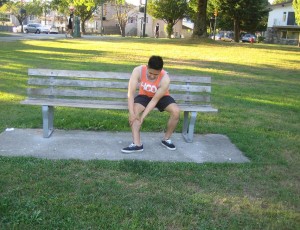The hamstrings are positioned in the rear upper part of the thigh that is comprised of three large muscles. It is important to note that the biceps femoris, semitendinosus and semimembranosus traverse from beneath the buttocks up to below the knee.
The hamstring muscles work by bending the knee and lifting the leg straight out to the back. These muscles are heavily used when running, squatting, jumping and during high-impact sports. The hamstrings can be tight and susceptible to painful injuries. Injuries can be avoided by understanding the usual causes of hamstring pain so that preventive measures can be taken.
Muscle cramps

The hamstring muscles can develop sore cramps. These cramps occur once the muscles forcefully and uncontrollably contract. Even though muscle cramps are not serious, they can be severe enough to temporarily stop an activity. A muscle cramp can last for seconds or minutes and then vanish completely.
In some cases, there is muscle soreness for a day or two afterwards. Working too vigorously, exercising without proper stretching before and after as well as being dehydrated will contribute to the development of muscle cramps.
Dehydration can result to imbalances in the level of electrolytes that can disrupt with proper muscle contraction and relaxation. It is important to note that training at the right intensity based on the current fitness level, warming up and cooling down and drinking enough water can minimize the risk. Once a hamstring cramp occurs, you have to stretch gently the muscle and hold the stretch until the cramp subsides.
Muscle tear
When it comes to a hamstring muscle strain, it can be mild or the muscle can tear which results to severe injury. Grade 1-2 strains involve incomplete strains but they can be managed with conservative measures. The grade 3 strains involve fully torn muscles. This level of strain is rare but can lead to severe pain, swelling, bruising and the muscle often ball up to a point that it can be felt and seen.
The grade 1-2 sprains and strains that are not treated can progress to a hamstring tear. A direct blow or accident involving the rear part of the thigh can cause this injury. The individual might need crutches for 1-2 months and in severe cases, surgery might be needed to repair the muscle.
Pulled muscle
The hamstring muscles can be pulled due to incorrect or excessive training. Take note that this injury occurs once the muscle is forcefully stretched. This typically occurs when the leg is straightened and weight is place on it at the same time.
The risk for a pulled hamstring muscle increases if the muscles are tight or if the quadriceps muscles at the front upper part of the thigh are stronger or when an individual who is out of shape works out too hard fast. A pulled hamstring muscle can cause stiffness, pain and swelling. The usual treatment options used include rest, application of ice, elevation and steady return to activity.To learn to recognize and manage muscle injuries, sign up for first aid training with a credible Canadian provider near you. In addition, it is important to use the right footwear and include a daily stretching program.
